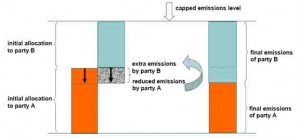Emissions Trading System
In the fight against climate change, the European Union has pioneered the use of market-based approaches, including, in particular the Emissions Trading System (EU ETS). This system harnesses the power of economic incentives to drive down greenhouse gas emissions and preserve natural eco systems cost-effectively.
What is Emissions Trading?
Emissions trading, also known as “cap-and-trade,” is a market-based approach designed to control pollutants by providing economic incentives to limit or reduce emissions.
How Does the EU ETS Work?
The EU ETS is the largest emissions trading system in the world, covering 27 EU Member States, Norway, Iceland, and Liechtenstein. Here is how it works:
- Capping Emissions
The EU sets a cap on the total amount of greenhouse gas emissions that can be emitted by participating entities, such as power plants, industrial installations, airlines and shipping companies.
- Allocating Allowances
Each entity is allocated and, or, acquires tradable emissions allowances, with one allowance representing the right to emit one tonne of carbon dioxide equivalent (CO2e). Allocation can be through mechanisms such as for free against benchmarks or via auctioning. Allowances may be acquired through trading in the “carbon market”.
- Ensuring Compliance
At the end of each year, entities must surrender enough allowances to cover their total emissions. Failure to comply results in heavy penalties.
- Trading for Efficiency
Entities that reduce their emissions require less allowances to surrender (lower compliance costs). If they have been allocated allowances for free, entities that reduce their emissions to a level below their allocated allowances can sell their surplus allowances to entities that need more. This creates a market where emissions reductions happen where it’s most cost-effective.

Figure: Schematic representation of how emissions trading works in practice.
Benefits of the EU ETS
Cost-Effective Reductions
By allowing the trade of allowances, emissions reductions happen at the lowest possible cost across participating sectors.
Flexibility and Innovation
The market approach encourages companies to explore innovative solutions, increasing their competitiveness.
Broad Coverage
The system covers power generation, energy-intensive industries, aviation, maritime transport and more, ensuring a comprehensive approach.
Transparency and Accountability
Strict monitoring, reporting, and verification rules ensure transparency and accountability for emissions reductions.
Malta’s Implementation
The Competent Authority for the implementation of the EU ETS in Malta is the Climate Action Authority. For any inquiries, please contact the Climate Action Authority at ets.caa@climateaction.gov.mt
Stay Informed
European Commission EU ETS Page: For more information on the EU ETS, visit the European Commission’s dedicated page.

